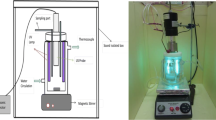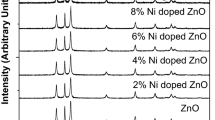Abstract
The degradation of Alizarin Yellow dye is studied here using the laser-induced photo-catalysis process in the presence of a zinc doped tungsten oxide catalyst. For optimization of the photo-catalytic process, the following parameters were investigated: dye concentration, laser irradiation time and incident laser energy. The calculated value of the reaction rate was found to be of a high value (k) = 0.197 (with estimated half-life of 6.5 min). This high value of k indicates the efficiency of this method in removing Alizarin Yellow dye from wastewater.





Similar content being viewed by others
References
Aksu Z, Yener J (1998) Investigation of the biosorption of phenol and monochlorinated phenols on the dried activated sludge. Proc Biochem 33:649–655
Bertoncini C, Raffaelli J, Fassino L, Odetti HS, Bottani EJ (2003) Phenol adsorption on porous and non-porous carbons. Carbon 41:1101–1111
Brandt S, Zeng A, Deckwer WD (1997) Adsorption and desorption of pentachlorophenol on cells of Mycobacterium chlorophenolicum PCP-1. Biotechnol Bioeng 55:480–489
Denizli A, Cihangir N, Tüzmen N, Alsancak G (2005) Removal of chlorophenols from aquatic systems using the dried and dead fungus Pleurotus sajor caju. Bioresour Technol 96:59–62
Fox MA, Dulay MT (1993) Heterogeneous photocatalysis. Chem Rev 93:341–357
Gondal MA, Sayeed MN, Seddighi Z (2008) Laser enhanced photo-catalytic removal of phenol from water using P-Type NiO semiconductor catalyst. J Hazard Mater 155:83–89
Gondal MA, Sayeed MN, Yamani ZH, Arfaj A (2009a) Efficient removal of phenol from water using fe2o3 semiconductor catalyst under uv laser irradiation. J Environ Sci Heal A44:515–521
Gondal MA, Dastageer A, Khalil A (2009b) Synthesis of Nano-WO3 and its catalytic activity for enhanced antimicrobial process for water purification using laser induced photo-catalysis. Catal Comm 11:211–219
Hameed A, Gondal MA, Yamani ZH (2004) Effect of transition metal doping on photocatalytic activity of WO3 under laser illumination: role of 3d-orbitals. Catal Comm 5:715–719
Kamat PV (1993) Photochemistry on nonreactive and reactive (semiconductor) surfaces. Chem Rev 93:267–301
Khalid M, Joly G, Renaud A, Magnoux P (2004) Removal of phenol from water by adsorption using zeolites. Ind Eng Chem Res 43:5275–5280
Li L, Zhu W, Zhang P, Zhang Q, Zhang Z (2006) TiO2/UV/O3-BAC processes for removing refractory and hazardous pollutants in raw water. J Hazard Mater 128:145–149
Munaf E, Zein R, Kurniadi R, Kurniadi I (1997) The use of rice husk for removal of phenol from waste water as studied using 4-aminoantipyrine spectrophotometeric method. Environ Technol 18:355–358
Pichat P (2003) Photocatalytic degradation of pollutants in water and air: basic concepts and applications. In: Tarr MA (ed) Chemical degradation methods for wastes and pollutants: environmental and industrial applications. Marcel Dekker, New York, pp 77–119
Slein MW, Sansone EB (1980) Degradation of chemical carcinogens. New York, Van Nostrand Reinhold
WHO/UNICEF, Report. Global water supply and sanitation assessment report. New York and Geneva, 2000
Acknowledgment
The author greatly appreciates the scientific cooperation with Prof. M. A. Gondal, Laser Research Laboratory, Physics Department, King Fahd University of Petroleum & Minerals, Dhahran, Saudi Arabia.
Author information
Authors and Affiliations
Corresponding author
Rights and permissions
About this article
Cite this article
Seddigi, Z.S. Removal of Alizarin Yellow Dye from Water Using Zinc Doped WO3 Catalyst. Bull Environ Contam Toxicol 84, 564–567 (2010). https://doi.org/10.1007/s00128-010-9995-y
Received:
Accepted:
Published:
Issue Date:
DOI: https://doi.org/10.1007/s00128-010-9995-y




